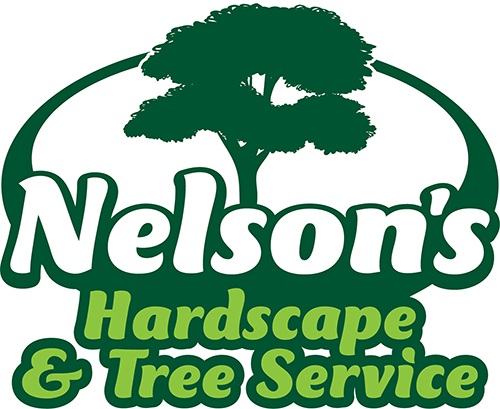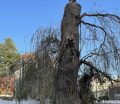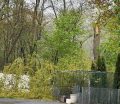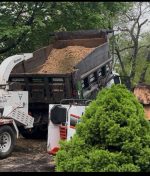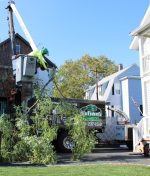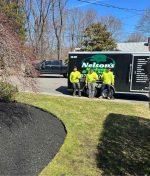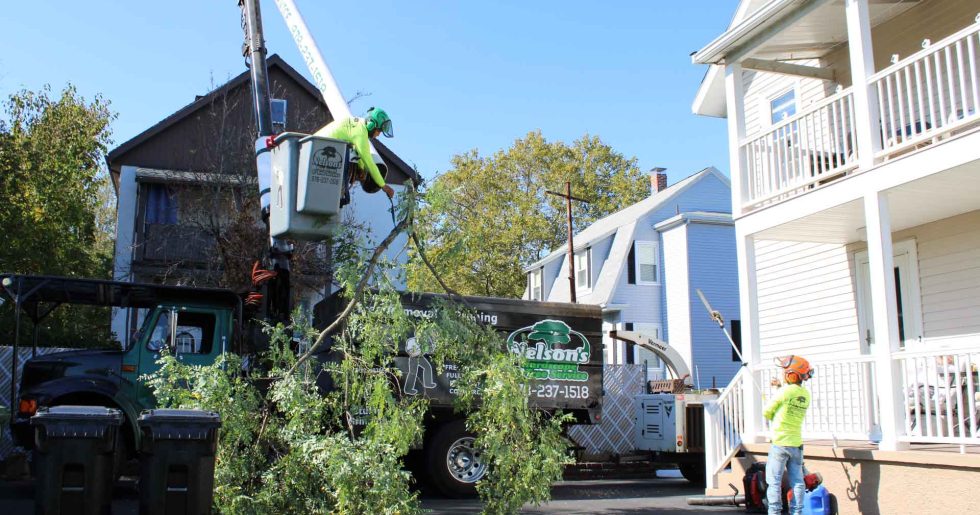
When a storm strikes or a tree suddenly becomes unstable, knowing how to respond can mean the difference between a minor inconvenience and a major catastrophe. Emergency tree trimming situations demand immediate attention, especially when branches threaten your home, power lines, or family safety. Whether it’s a lightning-damaged oak or a wind-battered maple leaning dangerously toward your roof, understanding how to handle these urgent situations is crucial for every property owner.
Tree emergencies don’t follow a schedule. They happen during storms, after heavy snowfall, or even on seemingly calm days when disease or decay finally takes its toll. The key to managing these situations effectively lies in quick assessment, safety awareness, and knowing when to call professionals. At Emergency Tree Service, Nelson’s Hardscape & Tree Service understands the stress and danger these situations create, which is why they offer 24/7 emergency response to handle tree hazards swiftly and safely.
Recognizing Tree Hazards That Require Immediate Action
Before diving into emergency response tips, you need to identify what constitutes a true tree emergency. Not every broken branch requires immediate professional intervention, but certain situations demand urgent attention:
Critical Emergency Situations:
- Trees or large branches leaning on structures or vehicles
- Limbs hanging precariously over high-traffic areas
- Trees in contact with power lines
- Split trunks or major structural failures
- Root upheaval or significant leaning after storms
- Blocking driveways, roads, or emergency access routes
Understanding these hazards helps you prioritize your response and communicate effectively with emergency tree services when you need help.
💡 Expert Tip: The 24-Hour Rule
Never wait more than 24 hours to address a tree emergency. What seems stable today can become deadly tomorrow, especially with weather changes. Document the situation with photos and contact professionals immediately—even if you think it can wait.
Tip #1: Prioritize Safety Above Everything Else
When facing a tree emergency, your first instinct might be to grab a chainsaw and start cutting. Resist this urge. Safety must always come first, and emergency tree situations are inherently dangerous, even for experienced individuals.
Immediate Safety Actions:
- Evacuate anyone from the danger zone (typically a radius twice the tree’s height)
- Keep children and pets away from the affected area
- Never touch or approach trees near power lines
- Establish a perimeter with caution tape or visible markers
- Document the situation with photos from a safe distance
If power lines are involved, contact your utility company immediately before anything else. Electricity and trees create a lethal combination that only trained professionals should handle. Many emergency situations also benefit from coordinated Storm Clean-up services that can address multiple hazards simultaneously.
Tip #2: Assess the Damage Without Getting Too Close
Once everyone is safe, you need to understand the scope of the problem. However, this assessment should be done from a safe distance. Emergency tree trimming scenarios often involve unstable conditions that can deteriorate rapidly.
Safe Assessment Checklist:
- Look for hanging branches (widow makers) that could fall suddenly
- Check if the tree is leaning more than 15 degrees
- Identify any cracks, splits, or exposed roots
- Note weather conditions that might worsen the situation
- Determine if the tree is touching structures or utilities
Take photos and videos from multiple angles. This documentation helps professionals prepare appropriate equipment and plan their approach. It’s also valuable for insurance claims. If the tree has completely failed and requires removal, you may need comprehensive Tree Removal services rather than just emergency trimming.
Tip #3: Contact Professional Emergency Services Immediately
Emergency tree trimming isn’t a DIY project. The combination of height, weight, tension, and unpredictable failure points makes it extremely hazardous. Professional arborists have specialized equipment, training, and insurance to handle these dangerous situations.
When you call for emergency services, provide clear information about the situation. Mention if power lines are involved, whether structures are damaged, and if there’s immediate danger to people or property. Professional services can typically respond within hours for critical situations.
The right professionals bring more than just chainsaws. They use rigging systems, cranes, and specialized cutting techniques to safely dismantle hazardous trees piece by piece. After the emergency is addressed, they can also provide Tree Cabling support systems to prevent future failures in weakened trees that don’t require complete removal.
Tip #4: Understand What Temporary Stabilization Can and Cannot Do
While waiting for professional help, you might wonder if there’s anything you can do. The answer is limited. Most temporary measures involve managing the perimeter and preventing additional damage rather than addressing the tree itself.
Safe Temporary Measures:
- Place tarps over damaged areas of your home if the tree has punctured the roof
- Set up barriers to prevent people from entering the danger zone
- Turn off utilities if the tree has damaged service lines
- Move vehicles or outdoor furniture away from the hazard area
- Clear small debris from safe areas (nothing requiring climbing or cutting)
What you should NOT attempt includes climbing the tree, cutting branches under tension, using ropes to pull on unstable sections, or working anywhere near power lines. These activities frequently result in serious injuries or death. If the emergency has also created stump hazards, professional Stump Grinding will be necessary once the immediate crisis is resolved.
Common Mistakes to Avoid During Tree Emergencies
Mistake #1
Attempting to cut branches that are under tension or compression without proper training
Mistake #2
Waiting until morning to call for help with critical hazards that need immediate attention
Mistake #3
Assuming homeowner’s insurance won’t cover emergency tree removal (they often do)
Mistake #4
Using improper equipment like household ladders or insufficient rope systems
Tip #5: Plan for Post-Emergency Tree Care and Prevention
Once the immediate crisis is handled, your work isn’t finished. Emergency tree trimming often reveals underlying health issues or structural weaknesses in other trees on your property. This is the perfect time to schedule a comprehensive property assessment.
Post-Emergency Actions:
- Schedule a full property inspection within two weeks
- Document all work for insurance purposes
- Review other trees for similar risk factors
- Consider preventive trimming for vulnerable trees
- Implement a regular maintenance schedule
Professional Tree Trimming and Tree Pruning services can identify and address potential problems before they become emergencies. Regular maintenance reduces emergency risks by 60-70% according to arborist associations. Proper tree care also includes maintaining your overall landscape through Lawn Care services that ensure healthy growing conditions.
Understanding the Cost of Delaying Emergency Response
Many property owners hesitate to call for emergency services due to cost concerns. However, delaying professional intervention almost always increases expenses significantly. A hanging branch that damages your roof during the next wind storm will cost far more than immediate removal would have.
Cost Escalation Factors:
- Structural damage to homes or vehicles
- Power line damage and utility company charges
- Injury liability if someone is hurt
- Additional tree damage from progressive failure
- Insurance deductibles and premium increases
Emergency tree trimming might seem expensive, but it’s always cheaper than the cascading problems that result from inaction. Most professional services offer transparent pricing and work directly with insurance companies to streamline claims. Additionally, addressing debris properly through Wood Chipping & Disposal services prevents secondary hazards and keeps your property accessible.
Preventing Future Tree Emergencies
The best emergency is the one that never happens. While you can’t prevent every tree hazard, proactive management dramatically reduces your risk. Regular inspections, especially before and after storm seasons, help identify problems early.
Prevention Strategies:
- Annual professional inspections for all large trees
- Regular pruning to reduce wind resistance and weight
- Cabling or bracing for trees with structural issues
- Removal of dead or dying trees before they fail
- Proper mulching and watering to maintain tree health
- Lightning protection systems for valuable specimen trees
Working with experienced professionals for routine maintenance is an investment in safety. They can spot early warning signs like fungal growth, cavities, or root problems that homeowners typically miss. Comprehensive property maintenance, including Lot Cleaning and Lawn Mowing, also contributes to overall tree health by reducing competition and stress factors.
Frequently Asked Questions About Emergency Tree Trimming
Q: How quickly should I respond to a tree emergency?
A: Critical situations involving structures, power lines, or blocked access require immediate response within the hour. Other urgent situations should be addressed within 4-24 hours depending on severity. Never wait more than 24 hours to contact professionals about any tree emergency, as conditions can deteriorate rapidly with weather changes or additional stress.
Q: Can I cut down a small leaning tree myself to save money?
A: Even small trees can be extremely dangerous when unstable. Trees under tension can spring unpredictably, causing serious injury or death. Unless you have professional training and proper equipment, attempting emergency tree work yourself isn’t worth the risk. The cost of medical care or property damage from a failed DIY attempt far exceeds professional service fees.
Q: What should I do if a tree falls on my house during a storm?
A: First, ensure everyone is safe and evacuate if necessary. Contact emergency services (911) if there are injuries or immediate dangers. Then call your insurance company and a professional emergency tree service. Document everything with photos. Don’t attempt to remove the tree yourself, especially if it’s touching power lines or has created structural instability.
Don’t Wait for Disaster—Get Expert Help Now
Tree emergencies demand immediate professional attention. Nelson’s Hardscape & Tree Service provides 24/7 emergency response throughout Lynn, MA and surrounding areas. Our certified arborists have the experience, equipment, and expertise to handle even the most dangerous tree hazards safely and efficiently.
Located at: 17 Bulfinch St, Lynn, MA 01904 | Available 24/7 for Emergencies
